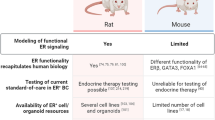The histological and immunohistochemical type of chemically induced (injection of N-methyl-N-nitrosourea into the mammary gland) breast tumor was studied in Wistar females. The tumor induced by N-methyl-N-nitrosourea was moderately differentiated adenocarcinoma with infiltrative growth lacking estrogen-α and human epidermal growth factor receptors, and expressing progesterone receptors; tumor cells were characterized by high proliferative activity. This variant of chemically induced breast tumor corresponds to human breast cancer luminal type B.
Similar content being viewed by others
References
Babichenkp II, Kovyazin VA. New Methods of Immunohistochemical Diagnostics of the Tumor Growth. Moscow, 2008. Russian.
Zavyalova MV, Telegina NS, Vtorushin SV, Perelmuter VM, Slonimskaya EM, Denisov EV, Cherdyntseva NV, Patalyak SV. Morphological study of luminal breast cancer. Sib. Onkol. Zh. 2013;(1):38-41. Russian.
Rodionova MV, Vorotnikov IK, Rodionov VV, Dudko EA, Chkhivadze NV, Kometova VV, Ryabchikov DA, Oshkina EV, Ozherelyev AS, Bogush TA. Prognostic and predictive significance of KI67 dynamic change during preoperative endocrine therapy in breast cnacer patients. Sib. Onkol. Zh. 2015;(5):102-109. Russian.
Slonimskaya EM, Vtorushin SV, Babyshkina NN, Patalyak SV. Role of morphologicaland genetic structural characteristics of estrogen receptor alpha in the development of resistanceto endocrinotherapy with tamoxifen in patients with luminal breast cancer. Sib. Onkol. Zh. 2014;(3):39-44. Russian.
Stenina MB, Frolova MA. Breast cancer: the most important scientific events and conclusions of recent years. Prakt. Onkol. 2011;12(1):6-11. Russian.
Chochieva AR. The study of the influence of letrosole on some factors of gormonal and metabolic status under experimental carcinogenesis of the mammary gland. Sib. Onkol. Zh. 2008;(1):100-102. Russian.
Allred CD, Allred KF, Ju YH, Clausen LM, Doerge DR, Schantz SL, Korol DL, Wallig MA, Helferich WG. Dietary genistein results in larger MNU-induced, estrogen-dependent mammary tumors following ovariectomy of Sprague-Dawley rats. Carcinogenesis. 2004;25(2):211-218.
Allred DC, Harvey JM, Berardo M, Clark GM. Prognostic and predictive factors in breast cancer by immunohistochemical analysis. Modern Pathology. 1998;11(2):155-168.
Dowsett M, Nielsen TO, A’Hern R, Bartlett J, Coombes RC, Cuzick J, Ellis M, Henry NL, Hugh JC, Lively T, McShane L, Paik S, Penault-Llorca F, Prudkin L, Regan M, Salter J, Sotiriou C, Smith IE, Viale G, Zujewski JA, Hayes DF; International Ki-67 in Breast Cancer Working Group. Assessment of Ki67 in breast cancer: recommendations from the International Ki67 in Breast Cancer working group. J. Natl Cancer Inst. 2011;103(22):1656-1664.
El-Abd E, Matta CA, Sheta M, El-Kerim Y, Sakr S. Histopathological characteristics of breast cancer and evaluation of ER alpha and Her-2neu using immunohistochemical and RT-PCR techniques. Alexandria J. Medicine. 2014;50(3):275-282.
Ferlay J, Soerjomataram I, Dikshit R, Eser S, Mathers C, Rebelo M, Parkin DM, Forman D, Bray F. Cancer incidence and mortality worldwide: sources, methods and major patterns in GLOBOCAN 2012. Int. J. Cancer. 2015;136(5): E359-E386.
Holowatyj AN, Ruterbusch JJ, Ratnam M, Gorski DH, Cote ML. HER2 status and disparities in luminal breast cancers. Cancer Med. 2016;5(8):2109-2116.
Liska J, Galbavy S, Macejova D, Zlatos J, Brtko J. Histopathology of mammary tumours in female rats treated with 1-methyl-1-nitrosourea. Endocr. Regul. 2000;34(2):91-96.
Pula B, Malicka I, Pawlowska K, Paslawska U, Cegielski M, Podhorska-Okolow M, Dziegiel P, Wozniewski M. Immunohistochemical characterization of N-methyl-N-nitrosoureainduced mammary tumours of Sprague-Dawley rats. In Vivo. 2013;27(6):793-801.
Author information
Authors and Affiliations
Corresponding author
Additional information
Translated from Byulleten’ Eksperimental’noi Biologii i Meditsiny, Vol. 163, No. 4, pp. 490-493, April, 2017
Rights and permissions
About this article
Cite this article
Kabakov, A.V., Lykov, A.P., Morozov, D.V. et al. Phenotypical Characteristics of Chemically Induced Mammary Tumor. Bull Exp Biol Med 163, 490–492 (2017). https://doi.org/10.1007/s10517-017-3835-6
Received:
Published:
Issue Date:
DOI: https://doi.org/10.1007/s10517-017-3835-6




